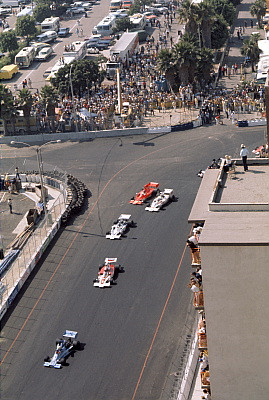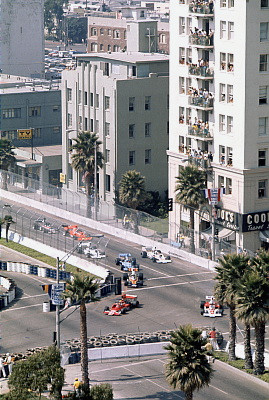That Way It Is/ Why Redman turned down Ferrari's F1 offer
by Gordon Kirby Many of you sent messages to say how much you enjoyed last week's column with Brian Redman. Some asked for more and because next weekend witnesses the 37th running of Southern California's Long Beach Grand Prix I thought, why not? After all, the inaugural Long Beach GP back in the fall of 1975 was won by Redman driving a Haas/Hall Lola-Chevrolet T332C Formula 5000 car. In 1976 the race became a round of the F1 World Championship before switching to CART and Indy cars in 1984. But in '75 it was the third-last round of the SCCA/USAC Formula 5000 championship ahead of the year's last two races at Laguna Seca and Riverside.
Many of you sent messages to say how much you enjoyed last week's column with Brian Redman. Some asked for more and because next weekend witnesses the 37th running of Southern California's Long Beach Grand Prix I thought, why not? After all, the inaugural Long Beach GP back in the fall of 1975 was won by Redman driving a Haas/Hall Lola-Chevrolet T332C Formula 5000 car. In 1976 the race became a round of the F1 World Championship before switching to CART and Indy cars in 1984. But in '75 it was the third-last round of the SCCA/USAC Formula 5000 championship ahead of the year's last two races at Laguna Seca and Riverside.
In those days F5000 was America's premier road racing series, taking over from the Can-Am which had died the year before. For a few years F5000 was very strong with Redman winning three straight championships for Carl Haas and Jim Hall's team, beating Mario Andretti and Al Unser Sr's similar Vel's Parnelli Jones Lolas. During that time All-American Racers ran a series of factory Eagles for a variety of drivers including Bobby Unser, Vern Schuppan, Elliott Forbes-Robinson and James Hunt. There was also a factory Shadow team with Jackie Oliver driving and Carl Hogan's team featuring David Hobbs. At Long Beach in '75 no fewer than forty-two cars showed up.

© LAT USA
On the second day of qualifying Redman's Haas/Hall Lola suffered a differential failure. In those days the pitstraight was on Ocean Boulevard and the cars turned right down Linden Street to join the current circuit and turned left up Pine Street later in the lap to rejoin Ocean Blvd.
"There was a bump in the road going into turn one and you jumped over it," Redman says. "You got off the throttle and the wheels got off the ground. Then you got back on the throttle as the car came down. And when I got back on the throttle the car went sideways because the limited slip in the differential had broken. I went into the pits and told Jim Hall the limited slip had broken and he said, 'I'd sure hate to tear it apart on the night before the race.' But they did. The team worked late and put in a new limited slip.
"I qualified fourth and wasn't too unhappy because I'd had this problem with the differential. When the race started Mario Andretti took the lead from Tony Brise, the brilliant protege of Graham Hill. Al Unser was running third and I was fourth.
"About the tenth lap as I went over the turn one jump I felt the diff break again. The car came down, and went whap! to the right. So I couldn't accelerate up the hill onto the old front straight anything like I could before and it was difficult in general coming off the corners.
"I was struggling and dropping back from the leading three. Then suddenly Mario was out with a broken gearbox and then Tony Brise broke a driveshaft and Al Unser hit the wall and now I was leading. So we won the race! It was a great win but at the same time it wasn't a great drive. It was a good drive under the conditions. I nursed the car through to the end and we were lucky to win."
That was Redman's fourth win of the year and he would go on to wrap-up his second straight F5000 title with a pair of thirds at Laguna Seca and Riverside. But as he prepared to celebrate his victory in the first Long Beach Grand Prix race promoter Chris Pook was distraught to discover that his race queen had gone missing!

© LAT USA
So now you know it wasn't just the drivers and teams who partied heartily in those halcyon days. And as Redman told us last week racing was so deathly dangerous at the time that everyone took the attitude: "Eat, drink and be merry for tomorrow we die."
In fact Redman actually turned down the offer of a Formula One drive for Ferrari because he didn't like the team's callous attitude toward its drivers. In 1967, his first year racing Formula Two cars, Redman finished second to Jochen Rindt at Crystal Palace in London. Redman was driving a Lola F2 car for a guy named David Bridges while Rindt was making his name driving his own Brabham F2 car. That and other performances caught the eye of Enzo Ferrari and his team manager and chief engineer Mauro Forgheiri.
"In 1968 I was summoned to Ferrari to test their Formula Two car at Modena," Redman recounts. "At lunchtime Forgheiri said, 'Brian, you see over there under the trees.' There was a figure standing there in a raincoat and Forgheiri said, 'This is Signor Ferrari.' Forgheiri was telling me to go faster!
"When I was testing we went to lunch at Maranello. I went into the dining room and there at the far end was Signor Ferrari with sixty engineers and technicians all sitting there talking. Signor Ferrari stood up and he was a very tall, imposing presence. He came walking slowly towards me with Mauro Forgheiri off to one side and on the other side Giacomo Callieri, public relations chief for Ferrari, and they stopped in front of me.
"I looked at Mr. Ferrari and put my hand out. I wasn't sure what to do or what to say. Signor Ferrari stuck his right hand out and gripped me by the cheek and shook me and he spoke the only two words that he ever said to me. 'Nice boy,' he said. Well, that was good enough reason not to drive for Ferrari!"
Following the test Redman raced an F2 Ferrari at the Nurburgring.

© LAT USA
That was on old trick often utilized in those days by Ferrari. But more lessons lay in wait for Redman on raceday.
"Early in the race a stone from another car's wheel hit me in the eye. In those days we were using WWII celluloid goggles. There was no protection really. So I drove slowly back to the pits and Forgheiri said, 'What's the problem?' I showed him and he said, 'It's okay. Where are your spare goggles?' I didn't have any so he gave me Ickx's dark goggles for the sun and I went back out.
"Down between the trees you couldn't really see all that well but I drove like a lunatic and finished fourth. I set a new lap record and was gaining on the leaders by about three seconds a lap. At dinner that night Forgheiri said he had spoken to Mr. Ferrari and for the rest of the year I would drive a Formula 2 car and in September I would drive a Formula 1 car in the Italian Grand Prix at Monza. And I said, 'No thank you.' Forgheiri said, 'No thank you! What do you mean?' I said, 'If I drive for Ferrari I'll be dead by the end of the year!'."
Four years later Redman signed to drive for Ferrari in the 1972 and '73 world sportscar championships. With drivers like Redman, Jacky Ickx, Mario Andretti, Ronnie Peterson, Carlos Reutemann and Clay Regazzoni the team won nine of ten races in '72 and two more races in '73.
Following his accident at the wheel of a Cooper F1 car at Spa-Francorchamps in 1968 and the deaths of great drivers like Jim Clark and Jochen Rindt, Brian's interest in F1 vanished. His great reputation rests today on his string of long-distance wins with Porsche and Ferrari and his trio of F5000 championships with Haas/Hall. He may not have won an F1 championship but Redman was one of the greatest drivers of the late sixties and early to mid-seventies. A fine, funny man who had both the self-confidence and temerity to turn down an offer to drive F1 for Ferrari.
Auto Racing ~ Gordon Kirby
Copyright 2011 ~ All Rights Reserved
Copyright 2011 ~ All Rights Reserved
Top of Page